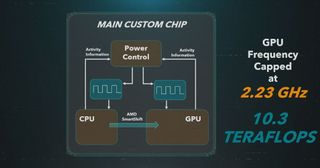The PlayStation 5 doesn't seem as fast as the new Xbox, but its SSD may be a secret weapon
It's an underwhelming reveal, but we still don't know what the PS5 will look like, or how much it will cost.

There were two console specs reveals this week, one of which landed with a monstrous pow and the other with a comparative whimper. Unfortunately for Sony, its PlayStation 5 was the latter. That's not to say it won't be a big upgrade over the PlayStation 4—it definitely will—but Sony's focus in Wednesday's reveal stream seems more heavily placed on storage than the GPU in its next-gen game console.
It's a gamble for sure, and it will be interesting to see how it plays out. In the meantime, we can compare the PS5's specifications to the Xbox Series X, and in turn speculate on what an equivalent gaming PC might look like (we'll have a separate article on that).
Here's a tidy breakdown of the PS5, detailed by Sony's Mark Cerny:
- CPU—8x cores @ 3.5GHz (variable frequency), custom Zen 2
- GPU—36 CUs @ 2.23GHz (variable), 10.28 TFLOPs, custom RDNA 2
- Memory—16GB GDDR5 w/ 256-bit bus
- Memory bandwidth—448GB/s
- Storage—825GB SSD
- I/O throughput—5.5GB/s (raw), 8-9GB/s (compressed)
- Expandable storage—NVMe SSD slot
- External storage—USB HDD support
- Optical drive—4K UHD

Like the Xbox Series X, Sony tapped AMD to build a custom system-on-a-chip (SoC) combining Zen 2 CPU cores with GPU cores based on its next-generation RDNA 2 graphics architecture. We've known that to be the case for a long while. Now, however, we have more details to digest.
The PS5 will feature 8 physical CPU cores and 16 threads. Sony did not go into great detail about speeds, but did say it will have a variable frequency, topping out at 3.5GHz. For reference, a desktop Ryzen 7 3700X (8 cores, 16 threads) sports a 3.6GHz base clock and 4.4GHz max boost clock. So on paper, the custom CPU inside the PS5 is a slower version of the 3700X.
It's also a bit slower than the CPU inside the Xbox Series X. Microsoft revealed its 8-core/16-thread CPU runs at 3.8GHz, or 3.66GHz with simultaneous multi-threading.
The GPU inside the PS5 is also a downgrade compared to the Xbox Series X. Sony revealed it consists of 36 compute units with a variable frequency capped at 2.23GHz, with 10.28 TFLOPs of graphics performance. The GPU inside the Xbox Series X sports 52 CUs clocked at 1.825GHz, and delivers 12 TFLOPs of performance.
The biggest gaming news, reviews and hardware deals
Keep up to date with the most important stories and the best deals, as picked by the PC Gamer team.
If we're looking for a comparable PC graphics card, the GPU in the PS5 has the same number of CUs as a Radeon RX 5700, but a higher clockspeed, more TFLOPs, and whatever benefits will be gained from AMD's next-gen RDNA 2 architecture. Hardware-based ray tracing is part of the package too, but otherwise, it's a bit underwhelming.
While respectable, the CPU and GPU are not exactly barn burners, especially for a system that is still 8+ months away from launching and expected to last for several years. Of course, this is simply looking at the numbers—raw power rarely tells the full story. The PlayStation 3's Cell processor, for example, was more powerful than the Xbox 360's PowerPC chip, but was also infamously much harder to develop for. This time around, though, the Xbox Series X and PlayStation 5 are built on very similar tech, so the raw power should be more comparable.
One major thing Sony's doing differently, though, is the SSD.
This is where the PS5 has an advantage over the Xbox Series X and PCs in general, and perhaps a big one. Sony is outfitting the PS5 with a custom (read: proprietary) 825GB SSD, using custom flash memory and a 12-channel interface. Why 825GB instead of more commonly found capacities, like 1TB? In a deeper dive shared with Digital Foundry, Sony says 825GB is the optimal capacity for the 12-channel interface.
"We can look at the available NAND flash parts and construct something with optimal price performance. Someone constructing an M.2 drive presumably does not have that freedom, it would be difficult to market and sell if it were not one of those standard sizes," PS5 system architect Mark Cerny says.

The result is 5.5GB/s of raw performance. Sony points out the PS5 can load 2GB of data in one quarter of a second, and 16GB of data in only 2 seconds. In addition, the controller links up to the CPU by way of a four-lane PCI Express 4.0 bus.
Beyond the raw figures, developers will have access to six priority levels, allowing for more important data to be fed into the system ahead of less important data. I'm not sure how exactly that will work, but it sounds like it will lead to much faster load times and vastly reduce screen transitions, or at least that's the hope. Sony threw out one-second game loads with no load screens as a possibility, immediate reloads after dying in a game, and "fast travel becomes so fast it's blink-and-you-miss-it."
Sony is also banking on a fancy hardware decompression scheme to bolster performance even further. As a result, the company equates 5.5GB/s of bandwidth to being more like 8-9GB/s.
Users will have the option of expanding storage with NVMe SSDs that are readily available for PCs. There's a catch, though. To take full advantage of the PS5's capabilities, a user would need to invest in a PCIe 4.0 model like this one. And even the fastest drives might still be at a disadvantage compared to the internal storage, because they lack the custom bits Sony has put in place on its proprietary storage, but it remains to be seen how that will play out.
So there you have it, the PS5 in a big, detailed nutshell. After the Xbox Series X reveal, I can't help but feel a little disappointed. That said, the PS5 could still surprise us, and we have no idea what either console will cost.
Paul has been playing PC games and raking his knuckles on computer hardware since the Commodore 64. He does not have any tattoos, but thinks it would be cool to get one that reads LOAD"*",8,1. In his off time, he rides motorcycles and wrestles alligators (only one of those is true).
Most Popular






